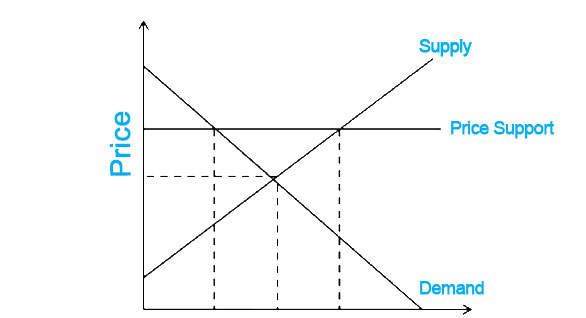
Market price support, also known as MPS, is an indicator that is utilised in the process of calculating Producer and Consumer Subsidy Equivalents, or PSE and CSE respectively. The market price support, or MPS, is the monetary value of the annual gross transfers of money from consumers and taxpayers to agricultural producers. It determines how much of a difference there is between the prices of an agricultural product on the domestic market and those at the border.
The solution proposed by the government to the problem of maintaining high prices was to purchase all of the goods on the market. Price supports are typically regarded as beneficial to the manufacturers of the goods because they ensure that the manufacturers will earn more money. In most cases, increased prices that are beneficial for producers are not beneficial for the consumers who are required to pay those higher prices.
The minimum support price, also known as the MSP, is the lowest price that the market is allowed to reach before the government steps in to intervene. The government first announces the MSP for a good before it is produced, and this is how the system works. The manufacturers will then be aware of the least amount of profit that they are able to make from the product.
A price support functions in a manner very similar to that of a price floor in that it establishes a base level for the market's prices. A price floor is the minimum price at which a product may be sold legally without violating any applicable regulations. The MSP will be provided to the producer by the government in order to close the gap.
Price floors and price supports both result in an excessive amount of goods being produced and sold on the market. When there is a floor on prices, the surplus of goods becomes the responsibility of the producer. The government has made a commitment to the producer through the use of price supports to purchase the goods at the support price. The government bears the responsibility of determining how the surplus should be utilised in some way.
When price support is applied to a market, it has the effect of driving up prices, resulting in an increase in surplus. Either the government can impose a production quota on producers or it can offer them incentives to reduce their output in order to meet the quota.
If there is a significant producer surplus, then it can be inferred that production at that price is profitable. However, this means that there are fewer customers who are willing and able to purchase at such a high price because they have suffered a loss. At the point where the market is in equilibrium, the consumer surplus and the producer surplus should, ideally, cancel each other out. Take a look at these explanations if you're interested in learning more about it and want to do so quickly.
The government needs to devise a plan to deal with the abundance of unused consumer goods that are currently being manufactured. One possible alternate is to offer an incentive to producers so that they will reduce their output. They also have the ability to establish production quotas, which limit the quantity of a given good that a producer is allowed to bring to the market.

The demand placed by the government is calculated by subtracting the quantity that consumers want from the quantity that is actually provided. The government makes these purchases in order to keep the price support intact and to keep it at a level that is higher than the price at which the market reaches equilibrium. The producers are the ones who benefit from the increased prices and a guaranteed sale to the government, but consumers still pay the same amount.
Even though price supports are beneficial for producers, they almost always have a negative impact on society as a whole. Consumers need to devise a strategy for dealing with higher prices, and the government needs to deal with overstock.
Farmers in the United States have reaped the benefits of agricultural price supports ever since the 1930s. Products whose prices are being artificially propped up include corn, soybeans, wheat, and rice. If a farmer does not have enough money to plant their crop and care for it all the way through harvest, the government will give them a loan that they do not have to pay back.
Price supports are prices that are set by the government at a level that is higher than the price at which the market is considered to be in equilibrium. These prices are maintained by the government's practise of purchasing surplus goods from the private sector at artificially low prices.
On the other hand, a price floor is considered to be a legal lower bound for the price of a good. A price support, however, is not. The producers have the option of selling their wares at a price that is lower than the support price; they are not required to offer them for sale at a price that is equivalent to the cost of production.
The primary effect that a price support has on a market is to drive up the price of the commodity that is being traded.
Price supports lead to an increase in the price of the good, which in turn produces a surplus and raises the level of the producer surplus.
A price support is a type of agricultural price support that is given to farmers in order to maintain a price of crops that is sufficiently high for them to earn an adequate income from the sale of their produce.